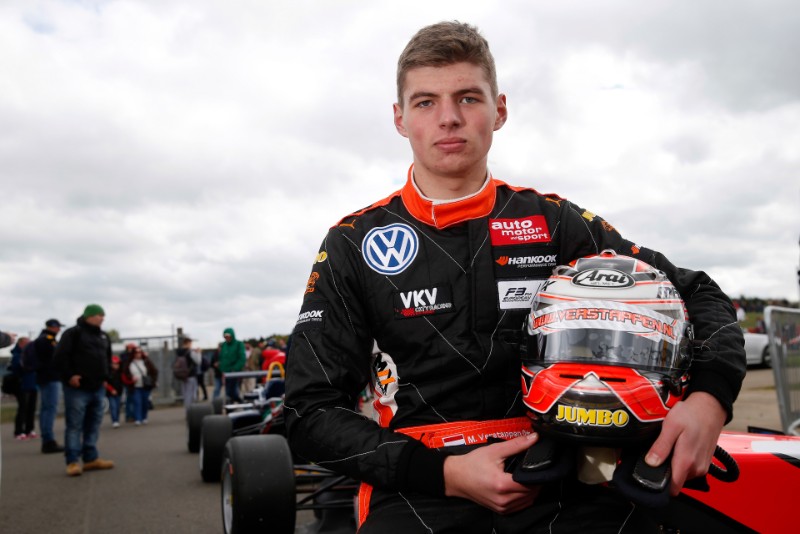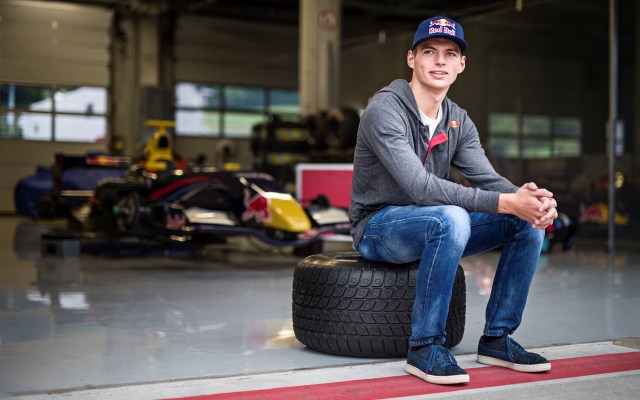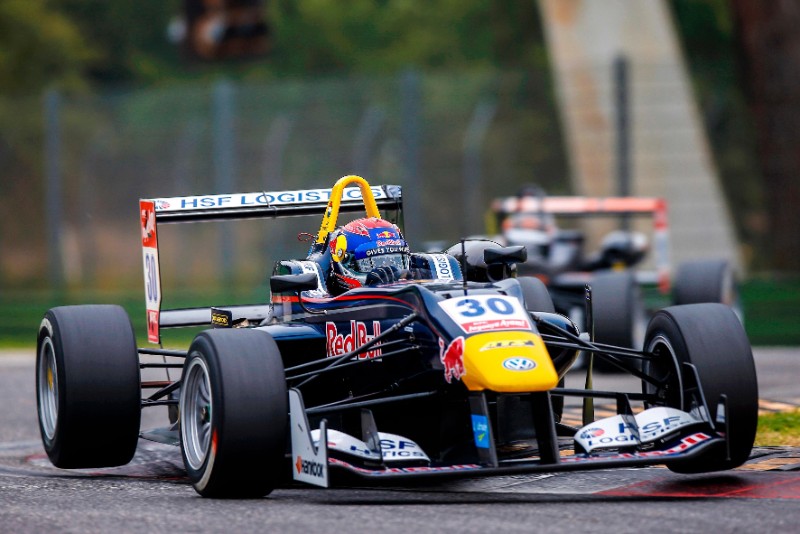
Photo: MGPC
10 years ago today, Max Verstappen debuted in F3. Less than four months later he joined Red Bull’s Junior Team, and the week after was signed by its second F1 squad Toro Rosso. But what if F1 hadn’t been waiting?
With hindsight, the decision by Red Bull to put Max Verstappen in a Formula 1 seat after just a year in car racing looks indisputable. But as Frits van Amersfoort says, an F1-ready talent was visible right from the day he appeared in Formula 3.
Verstappen had two top F1 teams, Red Bull and Mercedes, fighting over his signature just a few races into his F3 career. But which would he have partnered with had Red Bull not owned two F1 teams, the key factor that made a 2015 race seat possible?
Patience is a word absent from Jos Verstappen’s dictionary, and when it came to son Max he was always in a hurry to move on and up.
After a successful karting career, the younger Verstappen made his car racing debut in the Ferrari Driver Academy-organised and Formula Abarth-spec Florida Winter Series at the start of 2014. From 12 races in the entry-level cars he took two wins, three other podiums, three fastest laps and three poles.
Dutch team Van Amersfoort Racing had then been approached to run Verstappen in FIA European F3. But not by his dad.
Rather it was former F1 driver Huub Rothengatter, who had managed Jos’s career in the 1990s. Rothengatter “knew Max was something special,” VAR’s team boss van Amersfoort recalls to Formula Scout.
“Jos wanted to do Formula Renault [2.0],” he adds. “Together with Huub, I always said put Max straight in an F3 car. Forget about these single-make things like FR2.0 because they are highly political and when they don’t give you the right engine, you’re basically fucked.

Photo: Asensi Carricondo
“Jos wasn’t too convinced, so he kept his eyes on FR2.0. Max tested a lot of FR2.0 teams and cars and in December he tested for Motopark in F3 in Valencia.”
Verstappen “was totally fast but it was difficult for us in those days because somehow Jos was not convinced about our competitiveness”, admits van Amersfoort.
VAR took Jos Verstappen to the 1992 Formula Opel Lotus Benelux title, launching him on the path to F1, and by the early 2010s it was running mainly in German F3. That was less competitive than the European championship, and its debut season in the latter in 2013 certainly didn’t indicate any title-challenging potential.
After the month in Florida, “Jos was really unhappy” and felt that his son had not been given equal equipment. With the clock ticking down, it was Rothengatter who made the decision to commit to F3.
“There were many other people [around] Max who said ‘we are going to help’, but in the end they didn’t, and Huub put his money where his mouth was, put the money in to buy a car because we couldn’t finance the car ourselves and making the first down payment to get going, to pay the entry fees,” recalls van Amersfoort.
“We got a free engine from Jost Capito at Volkswagen, so that helped a lot. We put the car together and one week later we were on our way to Hungary for the first official test. On our way to Hungary, we stopped at Most in the Czech Republic to do the roll-out.
“From the beginning it was fantastic. Even before that we knew that it was going to be special. Of course, the pressure on us was pretty heavy, because we knew Jos was sceptical, but there wasn’t much to say from Jos’s side because Huub paid.”
Rothengatter and Verstappen subsequently fell out in a big way, “making war over a 16 year-old kid who still needed to prove himself”, much to van Amersfoort’s sadness.

Photo: FIA European F3
Third fastest in the two-day Hungaroring test, Verstappen then topped the times four days later in the second official test at the Red Bull Ring.
“In the first test we had a gearbox problem,” reveals van Amersfoort. “Jos jumped in his car and drove to Dallara, up and down. And the next morning he was back with a new gearbox. And that’s also Jos – everything for Max.”
The season opener took place at Silverstone on April 19-20, supporting the World Endurance Championship. Verstappen qualified fourth for race one but the team “suffered some technical problems with the car – we chose the wrong clutch and we had some clutch problems”.
Verstappen retired in race one, was fifth in race two then passed eventual champion Esteban Ocon to be second in race three.
“We changed the clutch and went to Hockenheim [for round two] and the technical mayhem started again because he drove pole but the car died on the outlap. It was the loom,” continues van Amersfoort.
“Eyebrows with Jos and bla, bla, bla, not easy, but the mechanics changed the loom between the races. That was fantastic because there was not much time and then he won the last race.
Verstappen would go on to score another nine victories, including a mid-season streak of six in a row at Spa-Francorchamps and the Norisring. “And then the whole roller coaster started…”
The teenager was now hot property in the car racing world. But Jos was determined to hold out for the best possible deal.
“There was already contact between Jos and Helmut [Marko, head of Red Bull’s driver development]. That also shows how good the view from Jos is on a talent like Max. He kept Helmut at bay.”

Photo: Philip Platzer/Red Bull Content Pool
Those conversations were unbeknown to van Amersfoort at the time, stressing that he was not party to any of the discussions directly, but he understood “that at the point where Max was winning, Helmut came back, and the deal was done”. The deal was finally signed following the series’ visit to the Red Bull Ring in early August.
Jos Verstappen said on his family’s website that he had been unable to sleep “for three weeks” prior to putting pen to paper.
“Especially during the Euro F3 weekend in Austria, when we talked to Dr. Helmut Marko. Every morning I was wide awake at 4.30am, whereas Max was sound asleep,” he admitted.
“I remember that Sunday morning, when we were phoning at six in the morning and Raymond [Vermeulen, the manager of both Verstappens] and myself were ploughing through several documents whilst negotiating. It was all very intense, also because Red Bull were so driven and engaging.”
The Verstappens then disclosed the 2015 F1 move to certain parties by inviting them to their house, including van Amersfoort.
“At a certain point in the middle of the season our team was invited to come to Limburg where [the Verstappens] lived and they told us in confidence that Max had signed for Toro Rosso. So, he moved straight from F3 to F1. Unbelievable!”
Once the Red Bull Junior Team membership was confirmed, VAR had to swap its team colours for the instantly recognisable Red Bull livery on Verstappen’s car. “But we were happy to do that, of course,” says van Amersfoort.
In the next round at the Nurburgring on August 16/17, engine reliability problems struck again. The unit “had to go back to [tuner] Spiess lots of times and in August it all went wrong because a conrod went through the engine and the [grid] penalty in those days was three times 10 places, but in the end, it also fits in the story”.

Photo: FIA European F3
There was a break of almost two months before round 10 at Imola, which was “a race weekend I will never forget” for van Amersfoort.
“Max was flying. And he did something you hardly see in F3 going from P11 to P2. It was incredible. What people never see is that the dramas in the paddock because Trevor Carlin was furious with Spiess thinking we had a special engine. It was absolutely fantastic!” he smiles.
“We had a normal Volkswagen. It was the days when F3 was really F3. In the end it was the best decision to do F3 because in those days F3 was much more free than now. You could do some things in the car. The engines of course were the real F3 engines. And it was a fantastic year.”
The car itself now belongs to Rothengatter, the man who put the money down to buy it in the first place. For a long period, it graced the entrance to VAR’s factory in the Netherlands but “is now hidden”.
Verstappen finished third in the standings, 67 points behind Ocon. But since it was a 33-race schedule, and more than a third of that gap was built by Ocon in a race Verstappen missed, he was only outscored on average by 1.31 points per race.
That impressed the motorsport world, but if no F1 seat had been available for 2015 what would Verstappen have done next?
As is now well-known, Red Bull ultimately won out over Mercedes-AMG in attracting Verstappen to its junior team because it could offer an immediate step up into F1, bypassing GP2 or Formula Renault 3.5.
“Max was very good in karting, was good in F3, and it was clear that he was a big one that’s growing,” said Mercedes-AMG F1 team principal Toto Wolff on F1’s Beyond the Grid podcast in 2023.

Verstappen in the DTM? (Photo: Jim Moir)
“We talked to them in the initial phases and it was a nice discussion with Jos and with Max as well But it was clear we couldn’t give him a seat because we had Nico [Rosberg] and we had Lewis [Hamilton]. We offered to support Max in Formula 2 [known as GP2 at the time], but since Red Bull was able to offer them the AlphaTauri seat – or Toro Rosso back in the day – it got Max into the seat.”
Had Red Bull had not had that benefit of owning two teams in F1, or had not been prepared to use it by placing him at Toro Rosso in 2015, would Verstappen’s career and possibly the last 10 years of motorsport have looked very different?
As Wolff explained, the best Mercedes could offer was GP2, where neither it or Red Bull had an affiliation with a competing team. Although Mercedes had supported young drivers for many years, its F1 junior team was only launched in 2014 and in its preferred path for F3 graduates had been to send them to DTM where its Mercedes-Benz touring cars were raced. Pascal Wehrlein was already in the DTM when the junior team launched, and after winning the 2015 title he got moved to F1 with the Mercedes-powered Manor team.
It is, however, inconceivable that the Verstappen camp would have considered spending a year away from single-seaters.
Wolff had a longstanding relationship with ART Grand Prix’s then-team boss Fred Vasseur, and the team competed in the DTM (with a Mercedes car) and in single-seaters. Ocon got snapped up by Mercedes in early 2015 and with ART GP made a sideways move to GP3 (now known as FIA F3), where he won the title and earned a 2016 graduation to the DTM with the team before joining Wehrlein at Manor later in the year.
That first move highlighted that ART GP’s GP2 seats for 2015 were already unavailable. McLaren junior Stoffel Vandoorne had one, and a partnership with Honda meant the other went to its protege Nobuharu Matsushita. So would Mercedes have had to look elsewhere? And if so, where?

Top team or cheap seat? GP2 was a no-go for Verstappen
With Verstappen’s talent and Mercedes’ backing, a seat would surely have been identified. But would he have had the equipment to defeat the dominant Vandoorne in a battle of the Belgian-born stars?
In any case, it is unlikely that Mercedes would have promoted him to F1 even for 2016 with Lewis Hamilton and Nico Rosberg dominating the previous two seasons. Would he have been farmed out to Manor, F1’s de facto backmarker team?
Though a seat there would hardly have matched the Verstappens’ expectations, he would have then been in an ideal position to be drafted into the Mercedes line-up after Rosberg’s surprise retirement at the end of the year.
Had Wolff known that Rosberg was going to retire at the end of 2016 would he have acted differently?
“Well, maybe, but if I would know where the stock market is next year, I would decide to invest in it or not. We would be very happy and rich people if we would know what happens in 12 months,” he said on Beyond The Grid.
He also told ESPN that while he “certainly” regretted missing out on having Verstappen in the Mercedes fold, “it wasn’t an option back in the day”.
For their part, neither Jos nor Max expressed any regret at turning down Mercedes, despite the team’s dominance from 2015 to 2020.
Red Bull had alternatives it could have presented Verstappen in 2015, both in and out of F1. In GP2, DAMS fielded one of its juniors, Pierre Gasly, alongside 2014 GP3 champion and Williams’ new development driver Alex Lynn.
Perhaps realising that Verstappen’s fast-track promotion meant his chances of progressing to F1 with Red Bull were rapidly evaporating, Lynn had left the RBJT by mutual agreement at the end of 2014.

Photos: Philip Platzer/Red Bull Content Pool
The alternative to GP2 in Europe was FR3.5, and Verstappen had tested a car in torrential rain at the Red Bull Ring on his first day as a Red Bull junior. Furthermore, that series was a proven step between F3 and F1 for Red Bull juniors, examples being Sebastian Vettel and Daniel Ricciardo.
Carlos Sainz Jr, another Red Bull junior, was 2014 FR3.5 champion with DAMS and Arden’s Gasly was a distant runner-up. They were two of the four contenders to be Verstappen’s Toro Rosso team-mate in 2015, and Sainz was the chosen one.
The risk for Verstappen, as father Jos understood very well, was that today’s hot prospect can very quickly go cold if the results don’t follow. Although it was Verstappen’s rapid rise that prompted, although the FIA would never admit it, the creation of the superlicence points system that tied drivers down to multiple years in junior series before being eligible for F1.
In 2015, Verstappen noted that Ferrari junior Raffaele Marciello had swept to the 2013 European F3 title then took one win in three GP2 seasons, and as far as single-seaters was concerned his star had faded. He didn’t want GP2 to stall his own career.
With no F1 drive potentially on offer, would Jos Verstappen have held off for another year in a junior series, hoping to reel in the top teams with another sensational performance?
That seems unlikely, as the Verstappens were already struggling to finance their F3 campaign without the inflow of Red Bull cash mid-season. A second season there would have been completely out of the question for the impatient Verstappens.
“I think we see now there’s a perfect match between Helmut and the family of Verstappen. They fit together,” concludes van Amersfoort.
“I knew that there was contact also with Toto but, you know, Mercedes is just more careful and the Verstappens don’t know what ‘careful’ is. They go for it and I think that the characters fit together perfectly and we see it now.
“Jos can really be a pain in the arse for the team but, whatever, he’s full throttle all the time. And as a team you have to cope with it. For sure, we learned a lot in that year,” he adds.
“To be the top you have to be special, and for sure Max was.”